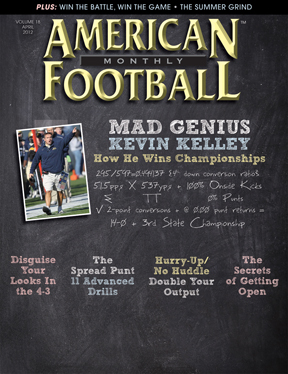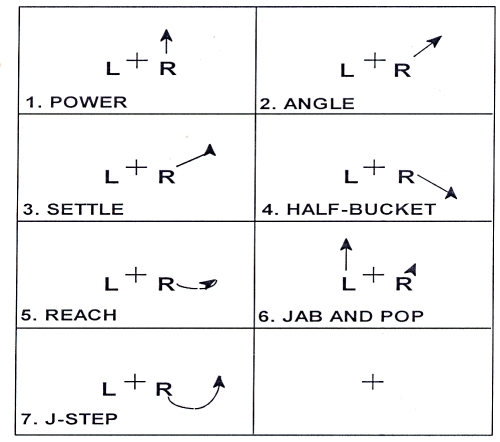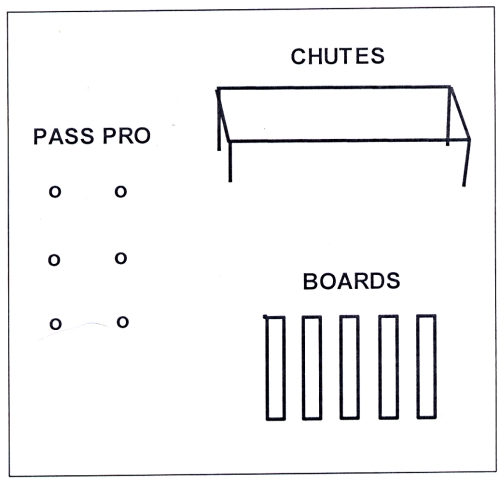Article CategoriesAFM Magazine
|
Developing Footwork for Your O-Linemenby: Scott LemnOffensive Line Coach Bridgewater College © More from this issue An offensive lineman has always had the advantage of knowing the play and the snap count. How he uses those pieces of information once the ball is snapped will determine the quality of the player and the overall unit. He must be able to move forwards, backwards, and laterally while driving an attacking defender in the process. He must accomplish this moving comfortably from what most would call an uncomfortable position. This is why nothing is more important than developing good solid footwork when developing an offensive lineman. Blocking schemes and rules can be taught, but good feet must be developed. From the start of practice, everything we practice at Bridgewater College starts with our footwork. Defining a player’s footwork starts in the meeting room. When installing a play, I give a target and the possible steps needed to reach that target. The reason for giving them multiple steps is because their step is relative to the alignment or distance to the target of the defender they have to block. The heavier or closer the target, the more vertical their step must be. The looser or farther the target, the more horizontal their step must be. A phrase I repeat numerous times on a daily basis is “step relative to your technique”. The first step is the most important because it is the “Set-Up” step. The first step is designed to set up the second step. We want to put ourselves in a great position for the second step because it is the “Contact” step. To develop this, I teach seven basic steps. (See Diagram 1).They are: 1. Power - vertical step Coaching Point: Step should gain ground without overstepping. 2. Angle – 45-degree step to cut off penetration. CP: Angle of shoulders should match the angle of the step. 3. Settle - a step gaining width and ground keeping the shoulders square. CP: Do not open the toe so the hips and shoulders will remain square. 4. Half Bucket - a step gaining width and losing ground keeping the shoulders square. CP: Do not open the toe so the hips and shoulders will remain square. 5. Reach - A horizontal step losing ground and opening up the toe. CP: The shoulders can turn but remain on an angle towards the LOS. Make sure the player is getting his weight over his leg. 6. Jab and Pop - Quick step with your outside foot helping to lower your hips then driving your inside leg and arm through half of the defender. This is a step used by the “Post” man in a combo or double team. CP: 1st step does not need to gain much ground if any. It is specifically to set up your 2nd step. Drag the inside arm to help slow down 2nd step so it is not a hop. Use the “Jab” step to set the angle of your combo or double team. 7. J-Step- A deep step losing ground and gaining width while opening the toe. CP: This is a “short pull” step and they are “running to reach”.
Diagram 1: 7 Basic Steps 7 Steps I start every practice with the seven steps. The players align by depth which allows me to see the entire group from every angle and be able to walk between them as well. This also allows me to take attendance of who is out at practice. This is the first thing we do for our warm up then progress into a dynamic warm up. We end every dynamic warm up with what I call the “Power Walk”. This is to get their bodies moving like offensive linemen. With a wide base, the players work on the inside thirds of their feet with a wide base in an athletic position. I will have them go forward, backwards, and on an angle. From here we are ready for practice. Following our dynamic warm up we progress into what I call “The Gauntlet” (See Diagram 2). It is a series of three drills where the players are in three groups and work through the drills. Each drill is designed to get the players ready for the specific movements it takes to play offensive line. It involves a Pass-Pro Drill, Board Drill with no defenders, and Power Walking under the chute. The Pass-Pro drill is designed to make them improve both their kicking and power. Boards are a great tool because it forces the player to take a proper step and helps to develop their base. Power Walking under the chutes trains the player to move comfortably from an uncomfortable position. The only section of the drills that varies each day is the Pass-Pro drill section.
Diagram 2: Gauntlet Gauntlet Set Up After The Gauntlet, we will move into the Board Drill with defenders. You can purchase a variety of different boards. I use old fashioned 2x6s from the hardware store. Depending on how long our individual period is depends on how many steps we will perform during Board Drills but we will always Settle, Half-Bucket, and Reach. The boards help us to continue to work on developing our footwork. The boards are set on a slight angle. Because we step to set up the 2nd step, it is important the 2nd step is driving up the board. 1. Settle: Put the toe of the foot you are stepping with against the board in the middle of it. This forces the player to step over the board. CP: Check to see if he is gaining ground like he should or “False” stepping. 2. Half-Bucket: Align with the middle of the foot you are stepping with on the far edge of the board. This forces the player to step over the board and lose ground. CP: Make sure the 2nd step is not lateral but up the board. 3. Reach: Align similar to the Half-Bucket step but leave a space between the foot and the board and move players up so their heels are even with the far edge of the board. This will force the player to open his toe as he steps. CP: Watch for players turning their upper body and not stepping properly. Make sure the 2nd step is not lateral but up the board. This is how we spend the first 30 minutes of every practice. It may be repetitive but I am a firm believer that repetition is the key to learning, especially in football. Following these drills we will work on either double teams or combo blocking. We do very little as a full unit until our inside period. |
|
| HOME |
MAGAZINE |
SUBSCRIBE | ONLINE COLUMNISTS | COACHING VIDEOS |
Copyright 2025, AmericanFootballMonthly.com
All Rights Reserved






